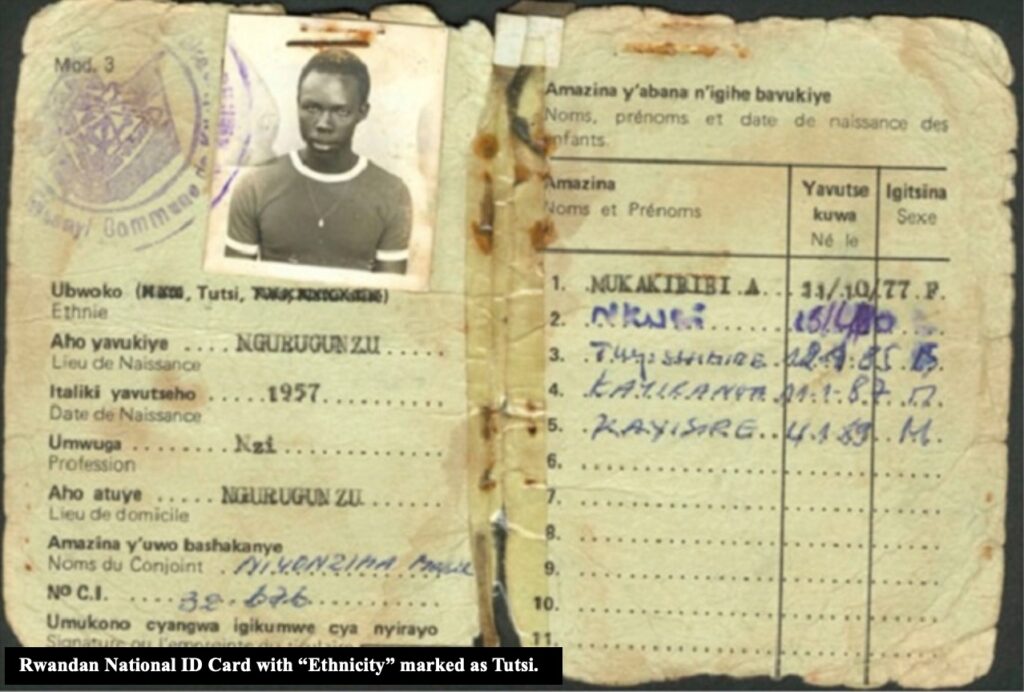- About Ramapo
- Academics
- Admissions & Aid
- Student Life
- Athletics
- Alumni
- Arts & Community
- Quick Links
- Apply
- Visit
- Give
Kwibuka 30, Panel 3
Rwandan National ID Card with “Ethnicity” marked as “Tutsi”
Rwandan Identification Cards
Colonial Belgium rule greatly impacted Rwanda and its racialization of the Tutsi and Hutu. In the 1930s, Belgium introduced national ID cards to Rwanda. After decolonization, Hutu extremists used these colonially rooted ID cards for their own purposes: to distinguish between Hutu and Tutsi. During the years of 1964-81, an identity card law mandated ID cards for everyone sixteen and above. These ID cards were used to restrict Tutsi from certain careers. It kept Tutsi inhabitants from entering the military and governmental positions. During the Rwandan Civil War (1990-1994) and the subsequent genocide, ID cards were required for security and nefarious purposes. Fear spread as well about allegedly falsified ID cars. Genocidaires thus sometimes elected to identify Tutsi based upon what they perceived as “Tutsi features.” Some Rwandan officials claimed that there were people with “Tutsi features” holding Hutu ID cards. Identification cards in these instances contributed to the fear of “enemies hiding among the population.”
The use and presence of ID cards were mentioned in genocide testimonies. In the year 2018, a trial took place in Paris over the 1994 Genocide Against the Tutsi. It involved accusations against two ex-Rwandan mayors of Kabaronda, a Rwandan town, Tito Barahira and Octavian Ngenzi. A survivor, Eulade Rwigema, brought the accusations in response to the murders of his wife and children. He claimed his Rwandan ID card was used to identify and persecute him. The cards were not only used to identify “racial distinction,” but also used as a tool with which to dehumanize Tutsi. While the use of ID cards that provide information about ethnicity does not automatically lead to genocide, it can, nonetheless, facilitates the process—first by aiding in identification and, second, by creating conditions in which people expect stark divisions between groups and respond violently to ambiguity.
Quick Links
Indangamuntu 1994: Ten Years Ago in Rwanda this Identity Card Cost a Woman her Life
Bibliography
Fussell, Jim. “Group Classification on National ID Cards as a Factor in Genocide and Ethnic Cleansing.” Prevent Genocide International. Yale University Genocide Studies Program, 2001. 2-4.
Mamdani, Mahmood. “When Victims Become Killers: Colonialism, Nativism, and the Genocide in Rwanda.” Princeton University Press, 2001. 88-89.
White, Kenneth R. “Scourge of Racism: Genocide in Rwanda.” Journal of Black Studies 39, no. 3 (2009): 471–81.
Photo Credit
De la Croix Tabaro, Jean. 2015. “The Passport to Death: Story of Rwanda’s Notorious ID.” KT PRESS. July 13, 2015.
Copyright ©2025 Ramapo College Of New Jersey. Statements And Policies. Contact Webmaster.


Follow Us!